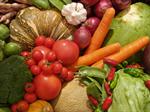 How to Grow Vegetables
How to Grow Vegetables
There are many different ways you can grow vegetables, and an almost endless range of varieties to choose from.
The method you choose and the varieties you grow should depend upon the time, space, level of knowledge and other resources available to you.
One Way of Growing Vegetables - the "No-Dig" Method
A productive vegetable garden needn't take up a lot of time either, by using the "No-Dig" method of gardening a vegetable garden of generous size could be assembled in a mornings work.
The method used in this type of garden is quite simple, layers of material are placed on top of the ground and seedlings are planted with a handful of soil. The materials needed would be found on most farms: old hay, straw, newspapers, manure and some fertiliser such as blood and bone are all that is needed. If the ground is very hard or rocky it is advisable to put down a thick layer of old hay (about 20cm) first and then build your layers up from there, kitchen scraps can be incorporated into the mixed layers alternating with manure, spoilt hay blood and bone etc. It is advisable to water it all as you go along and top it with wet overlapped newspapers and a layer of old straw to keep it all in place. Holes are punched into the paper through the straw and the seedlings planted with a handful of soil. No weeding required. This method also requires less water as the mulch is extremely water retentive. Most vegetables thrive in this method. Crops that need seed to be sown directly into the soil such as carrots and onions could be planted in a conventional patch on their own.
Seeds are very cheap, a few packets of seeds such as cabbage lettuce etc. has potentially hundreds of plants in them. It is well worth the effort to grow your own seedlings as well. A lot of farm produce stores also sell seeds such as corn, peas and seed potatoes (tubers) and onion sets in bulk, translating into a further cost reduction.
Once your garden is established and producing vegetables you will most certainly find yourself with a glut.
Of course to be relatively self-sufficient a lot of the produce you can't consume immediately could be preserved for use later. Fruits such as strawberries, blackberries etc. can be turned into jams and jellies for later use or for sale. Corn freezes well as do beans and peas. Potatoes can be stored in the ground for as long as possible, just lift up the mulch and take what you need on a daily basis. Towards the end of winter remove the top mulch and store the remaining potatoes in a cool dry place. Tomatoes can be turned into sauce, paste, or bottled for use over the winter months. Eat what is in season.
If you want to learn more about self-sufficiency and organics, we offer a great range of courses from Permaculture to Healthy Buildings.

|
Fruit, Vegetables & Herbs - PDF Ebook
What could be nicer than eating fresh food straight from your garden? This full colour ebook will show you how to grow your own fruit, vegetables and herbs; saving you money and providing a source of joy and relaxation. Click here for more details |
